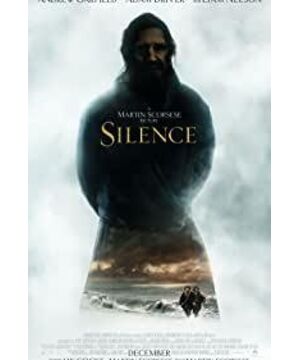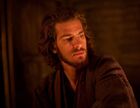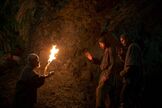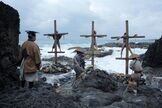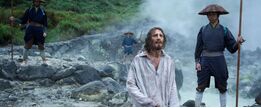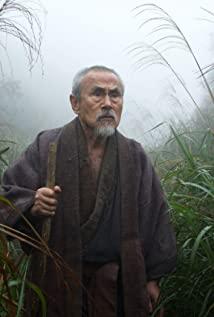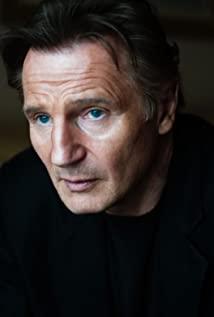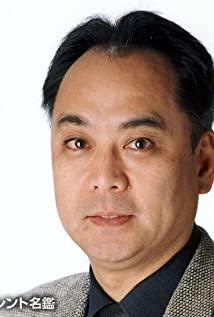"It is easy to die for the beautiful and good things; it is difficult to die for the miserable and corrupt things." ──Endo Shusaku, "Silence"
"Silence" (Shen Wei; Silence) has been published so far Two films: the Toho version in 1971 and the Paramount version in 2016, invariably made a choice, that is, a large number of the scenes of the Japanese servant Yoshijiro were deleted and replaced by Father Ferreira. It’s not difficult to understand that the original Yoshijiro is a character who appears frequently but is not likable. He is ordinary, cowardly, fox fake, and betrays his companions many times. For the sake of the length and drama tension, the film wants to be more dramatic with his background (abandoning his education) Ferreira of Buddha replaced Judas and played a dialectical role with the protagonist Father Rodriguez, which is reasonable and reasonable.
However, Yoshijiro is by no means just a Judas. On the contrary, he is the real protagonist of "The Silence". The author Shusaku Endo gave him the dialectical proposition of the story of "The Silence" (both novels and movies) with the deepest force and the most complex imagery—"the weak". The restoration of rights.
The so-called strong and weak do not refer to physique, property, and status, but the willpower for faith. Christianity is justified by faith. Christian believers cannot follow Christ only by relying on a mentality of dependence or speculation, and they must have strong faith and perseverance in order to gain the status of the Lord and the Church. The training of Job in the Old Testament and Peter's confession of the Lord in the New Testament are all narrating that believers must train their own willpower, not be beaten by foreign objects, and become a strong believer and a strong will.
Rodriguez and Father Calope were once such strong men. Their trip to Japan is always ready for martyrdom. The speculative look of Yoshijirogu, who is deeply unwilling to lead the way, repeatedly abandons his religion and asks for pardon, even if he witnessed the execution of his family is sympathetic. However, when they set foot in Japan, everything they saw and heard hit their core doubts about Christianity. The poor people in Nagasaki, the enslaved believers in Nagasaki, and the behavior of using rosary beads as treasures for blessing made them doubt: Compared to believing in God, these farmers listened to sermons more like a figure in exchange for self-esteem. What came next was a series of trials of insulting icons arranged by Chikugo Shou. "Buddhist believers are justified out of dependence, while Christian believers must have the will." Chikugo Shou is very clear. Compared with torture, torture is the biggest weakness of believers in Christianity who think they are strong.
So they became weaker. Ferreira’s oral message gave the Roman messenger the final blow. This devout priest who worked hard, devoted himself to the mission, witnessed the Japanese Christianity treating God as the sun (big day), and realized that the doctrine of Christianity is in Japan. Already put on the color of his mortal enemy polytheism, his long-term betting was only a foreign object, which made him desperate. He began to be unable to bear the pressure of being alone in a foreign land, and longed for Father La Rodríquez to join in the ranks of abandonment. Rodriguez couldn't refute all of this, because he heard and heard in Nagasaki, and his confidence in the preaching was shattered. Ferreira and Rodríquez degenerated from self-confessed strong to weak.
However, what about being a weak person? The Christian faith exists precisely for the weak, because Jesus Christ died not for the Pharisees and the old strong, but for the one who betrayed and denied himself, and only dared to watch him bleed and died on the cross. Group of weak.
This is the meaning of Yoshijiro's role in "The Silence". The Taiwanese version of the novel translator Lin Shuifu bluntly stated in the book preface that Yoshijiro is the protagonist of the book, because he is an absolute weak, how such a person walks in the world is the ultimate path that Christ and Christians pursue. Rodriguez watched all the way watching Yoshijiro willingly become Judah again and again, and then regretted re-recognizing the Lord after another time, just like a lizard that had broken its tail and grew up again. From disgust, disgust, questioning, and wavering, he gradually began to introspect, and his faith wavered. He gradually began to be able to emulate the same, and then reflect: a believer does not have a strong will to believe, this matter itself should be tolerated by Christ,
Rodriguez and Yoshijiro reflect each other. He was once a strong man, hoping to be martyred vigorously. He realized in Yoshijiro that he couldn't even forgive Yoshijiro for betraying himself for money. How could such a noble sentiment of caring come from? This impulse to martyrdom is not out of the mercy of the priesthood, but the desire to become a hero. But is there no pain for the weak? Every abandonment of religion may be a heart-wrenching parting, no easier than martyrdom. But Christ can do it. "It is easy to die for beautiful and good things; it is difficult to die for miserable and corrupt things," he thought.
The ending of "Silence" is therefore ambiguous. Rodriguez finally chose to abandon religion and became an accomplice in filtering, censoring, and judging Christians in Japan. However, he did not feel that he was wrong. Instead, he was convinced that Christ had spoken to himself and allowed his actions, and he was still In declaring the righteous deeds of Christ, he still lives for Christ in his whole life. Did he really hear the dialect of Christ, or did he deceive himself? Did he comprehend the wise way of seeking completeness, or did he go back to the cowardly and unowned road like Ferreira? What attitude did he and Ferreira hold towards the Japaneseization of Christianity? ..... Everything is hanging in the air.
These ambiguous areas are the shifting of the spectrum of the strong and the weak of the insecurities. They are also the epitome of the many Japanese believers in the eyes of Shusaku Endo, as well as the human nature. In 1947, before he became a novelist, he mentioned in the article "The Problem of the Catholic Writer": "The purpose of a saint or poet is to sing praises to God intently. However, since a Catholic writer is a writer, his most important thing is Obligation is to stare at people, and it is never allowed to give up the obligation to stare at people.” (Translated by Zheng Yinjun), I think it is not difficult to write saints (ultimate believers). It is Christianity to write humans like Peter and Paul who have betrayed Christ and struggled. What the creator should look at.
In 1971, Toho put "The Silence" on the screen. The director was Masahiro Shinoda, and the screenwriter was written by Endo Shusaku himself. This film is not so much an adaptation, it is more like a footnote. Endo, without destroying the original story, pulls out the historical facts of the Nagasaki missionary case that has been downplayed by the novel, which clearly shows that the foreign countries are suspected of interfering in the national conditions of Japan by preaching and magnifying the cultural conflict. . Father Rodriguez’s enemy is not only his own voice, but also the cruel cruelty of Japanese officials in the seventeenth century.
It is worth noting that the "strong" and "weak" in this film are not only reflected in the story, but also in the form of the image. When the whole film canceled the first-person narration dominated by the epistle in the original novel, and replaced it with an objective and omniscient camera perspective, it was equivalent to shifting the perspective of interpreting events from the priest who murmured to the reader to everyone, and the inequity of the right to speak was lost. Disintegrated. The symbols of Japan (family crests, temples, kimonos, etc.) also eroded the body and mind of Roman priests step by step through ubiquitous close-ups.
When Rodríquez saw the believers in Nagasaki being hung from the ground, and gradually marching toward the valley of the shadow of death, Ferreira stood silently and persuaded him to abandon his religion. The wall juxtaposed with Ferreira under the camera was already mottled. Lettering LAUDATE DEUM (Praise the Lord!), the most sacred words are powerless in the most filthy world and can only be observed. In the end, Rodriguez, who was abandoning religion, had a frantic friendship with Monika, while Yoshijiro, who was far away, held the girl in Huajie and wept bitterly, regretting that he could not hold on to his faith. The lust of the female body and the torture of officials have become Japan’s candy and whip. These weak people are drawn into the bottomless and degenerate world.
So the biggest problem with the 2016 movie "Silence" appears here.
At first glance, the structure of the 2016 version is more restorative than the 1971 version of the original novel: as well as real foreign actors, more realistic location settings, longer details, first-person narration, and a diary of Catholic residential officials that complement the original postscript. . However, behind the sidelines, the theme of the whole film has changed. What becomes? It becomes the interpretation written by director Martin Scorsese in the preface of the new edition: "On the surface, faith and doubt are incompatible, but I think the two go hand in hand and nourish each other. Doubt can lead to serious alienation. But if you coexist with faith-true faith, always faith-in the end you can reach the ultimate joy of merging the two. It is this painful and contradictory process-from conviction to doubt to alienation to fusion-Endo Zhou Zuo knows very well, and made a clear, delicate and beautiful interpretation
of "The Silence" ." In other words, the 2016 "Silence" shifted from the dialectic between the strong and the weak to the contending between the believer and the doubter. Rodriguez is not a weak person, but a "doubt" who seeks doctrine.
The plot of the story that Father Rodriguez and others encountered has not changed. The same is the poverty and backwardness of Nagasaki, the repeated betrayal of Yoshijiro, the malicious test of Chikugoshou, the painful confession of Ferreira, and the abandonment of religion. End up. However, the expressions of their characters have changed. The faces of every Catholic priest have become resolute and tough, and even if they are trapped in prison or witnessing tragedies, they still have an extremely powerful and self-thinking leeway. All the dialectic of the story takes place in Rodriguez’s off-painting narration, that is, his mind, the ubiquitous subjective lens, reveals that everything happening before him and his inner world are separated from each other, and the relationship between reality and faith is also true. .
Father Ferreira's changes are even more obvious. When he first appeared in a Buddhist temple in the movie, the humble, gloomy prisoner in the original work, who "exudes the scent of promise, like a dog on a chain," has completely become tall, heroic, without hesitation, and connected. A faith giant with the heroic face of Ennison; if it were not for his introduction, the audience would even think that he was the master of this temple, rather than the small Chikugo guarding Inoue on the side. The Japanese quagmire said in his mouth, not only is it no longer like a past that was forced to accept after being physically and mentally hit, but more like a doctrine of a scholar who has been observing the world for several years, chewing and self-chosen to believe. A strong, calm, and upright interpretation of a foreign country.
This journey to the east of the Roman priest became a journey of Job for the priests who traveled to different places to self-diagnose, test, and ponder between doubt and justification, and then to cherish each other in the thorns. The end of the journey is an original ending. The remains of Ferreira and Rodríquez are placed in the coffin with a cross in their hands, showing that they still serve the Lord throughout their lives, thoroughly emphasizing their humiliating minds and their martyrdom for their faith. The Japanese officials and the Dutch messengers did not know, but they knew that they had been thinking about faith and suspicion throughout their lives, reaching the "extreme joy of merging the two." The doubters will eventually become believers.
The question is, can everyone really bear such a dialectic? At least Endo Shusaku said no, otherwise there would be no Yoshijiro.
This is the biggest problem with the 2016 version of "The Silence". It downgraded this religious story to a rough and arrogant heroic journey that originally pointed to the universal struggle of human nature.
The so-called believers and doubters are bluntly strong, because when a person can dialect faith and doubt, be a self-confessor, and Baiyun Cangdog still does not change his will, the willpower and thirst for knowledge will inevitably be unparalleled. . These are things that the weak can't do, for example, Yoshijiro can't. He would betray his comrades for a few silver coins, lie that he was a Roman messenger for the sake of prestige, and spit on him in order to save his life. He would never be able to keep his promises to others and God. This is the weak nature of his belief.
Christ sacrifices for the weak, and Christianity exists for the weak. Endo Shusaku wrote his book because he sympathized with the weak, but the most negative of the 2016 edition of "The Silence" is the weak. Yoshijiro's betrayal has been cut a lot like the scenes, and the mirror image meaning that "there is no strong and weak in faith, Christ only cares for the weak" has also been erased. When Rodriguez heard his confession in prison for the last time in Nagasaki, the priest’s eyes were disgusted and hesitant. Yoshijiro’s confession was so vain and ethereal under the shaking of the camera, as if the picture of his spitting sacred painting was taken by the objective lens. However, as if the person in charge of the camera did not want to see the icon being insulted, Yoshijiro was sentenced to not be included in the ranks of Christ's equal salvation like other believers outside the prison. He was only worthy of being sympathized, but not worthy of being saved.
Isn't this just the arrogance of the strong? When the dialectic of belief and doubt does not occur in the confrontation between two characters (the treatment of the novel in 1966), nor the friction between a person and a country (the treatment in 1971), but only occurs in the present situation. In a person's mind and mind, that is the belief of the strong. In 2016, it was the "Silence" that only belonged to the strong, and it completely negated the heroic story of Shusaku Endo and the ultimate care, and that only the strong are qualified to call themselves believers.
This is not surprising. Why do so many viewers after watching the 2016 version of "Silence" think that the conclusion of this movie is superficial "The meat and wine have passed through the intestines, and the Buddha stays in the heart". After all, under the overwhelming self-drinking narration and the ubiquitous discussion of the strong, Endo Shusaku tried to explain the maternal beliefs, the care for the weak, the conditions of Japan, and most importantly, the unique Christian troubles of Rodríquez and Yoshijiro: Insin Justified, is there any room for plot to come out and breathe? A story that hasn’t been told, the audience can see, naturally, only patience is left.
What is "silence"? In the original novel, silence can be God’s silence on human suffering, or the silence of two priests who chose to abandon religion in Japan; in the 1971 film, silence can be the prayer of Nagasaki believers being hung in the cellar. Yin, was gradually tortured to the silence of death that couldn't speak. The 2016 version is none of the above. There is no person in the film that is silent at all times: Rodríquez, who has a lot of heart after his death, and Ferreira, who is almost like the king of the mountain in Japan, repeatedly used his family crest and special envoy. The reverberating Japanese officials and the nearly three-hour-long and cumbersome Nagasaki followers all rushed to the spotlight in an extremely loud manner.
Only the weak in these beliefs like Yoshijiro are excluded by the camera and narration. This is also the main reason why the 2016 version of "The Silence" is difficult to be liked. Whether Martin Scorsese or these foreign crews, they are motivated by some unknown reason (oversight of adaptation? No interest in history? The arrogance of European believers. ?) For these historical protagonists, Yoshijiro once again gave them the tragedy they encountered in the past: they were "silent".
(This article will be published exclusively in ViewMovie, if you want to reprint, please ask for confirmation first)
View more about Silence reviews


